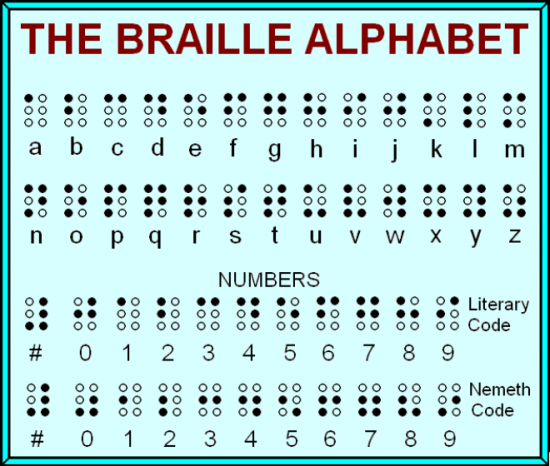I have this question, given i might use it in some story. The standard Braille (including the variation for current Greek) uses cells of 6 dots, for each letter (or along with grammar symbols), so the full amount of possibly different symbols in each cell is given by 2X2X2X2X2X2, ie probabilities of arrangements differing, with full repetition included (and 2 is there since there are only two possibilities for each dot of the cell, namely either a raised or a deepened cylindrical dot- or an absence of any dot to stand for the previous case).
The full possibilities therefore are 64, but Braille himself did not mean the empty set to be used (eg no raised dots at all in the cell).
A couple of other questions too:
-In finishing a line, or an entire book, does one use a 'fullstop' symbol anywhere? Also are commas used? (i know that pronounciation marks are used when they are needed, eg in Greek Braille).
-How would one go about creating a manuscript of Braille using just a pen and paper? (ie is it reasonably easy? And if not, would there be some common instrument to use instead of the pen?).
-Some images of printed books using Braille show a third variation, not just raised dots or inverted such dots, but also absence of any dot. Is that more standard or not?
Thanks in advance
http://en.wikipedia.org/wiki/Louis_Braille

The full possibilities therefore are 64, but Braille himself did not mean the empty set to be used (eg no raised dots at all in the cell).
A couple of other questions too:
-In finishing a line, or an entire book, does one use a 'fullstop' symbol anywhere? Also are commas used? (i know that pronounciation marks are used when they are needed, eg in Greek Braille).
-How would one go about creating a manuscript of Braille using just a pen and paper? (ie is it reasonably easy? And if not, would there be some common instrument to use instead of the pen?).
-Some images of printed books using Braille show a third variation, not just raised dots or inverted such dots, but also absence of any dot. Is that more standard or not?
Thanks in advance

http://en.wikipedia.org/wiki/Louis_Braille


